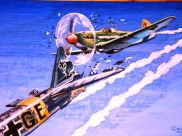Grumman AA-5 Traveller
Four-place aircraft, named the American Aviation AA-5 Traveler, was powered by a Lycoming O-320-E2G engine of 150 hp (110 kW). It would carry four people at 121 knots (224 km/h) cruise speed and was certified under US FAR Part 23.
Production of the Traveler had just started in 1971 when American Aviation was sold to Grumman and became the Grumman American division. Grumman continued production of the Traveler. 834 Travelers had been produced when production of this model ceased in 1975.
Grumman American AA-5 Traveler
The Grumman American AA-5A Cheetah "leaping cheetah" emblem that differentiated the AA-5A from the earlier AA-5 Traveler
Grumman American AA-5B Tiger
The Grumman American "Galloping Tiger" emblem adopted to differentiate the AA-5B Tiger from earlier AA-5 models
A redesign of the AA-5 was undertaken in 1974 and as a result the 1975 model Traveler featured an aerodynamic clean-up of the engine cowling and main gear fairings. The tail section remained unchanged. As a result of these changes the 1975 Traveler had a cruise speed of 127 knots (235 km/h). The Traveler was superseded in production the following year by the further refined AA-5A Cheetah.
Grumman AA5 Traveler performance and specifications
Horsepower: 150
Gross Weight: 2200 lbs
Top Speed: 130 kts
Empty Weight: 1271 lbs
Cruise Speed: 122 kts
Fuel Capacity: 38.00 gal
Stall Speed (dirty): 50 kts
Range: 503 nm
![]()
Takeoff
Landing
Ground Roll: 880 ft
Ground Roll 380 ft
Over 50 ft obstacle: 1600 ft
Over 50 ft obstacle: 1100 ft
![]()
Rate Of Climb: 660 fpm
Ceiling: 12650 ft
The four seat AA-5 is a larger derivative of the AA-1, and shares 60% of the smaller aircraft's structures. It is basically (to accommodate four seats), therefore heavier, and has a more powerful engine. It first flew in 1970, and first aircraft were delivered late in 1971. In 1972, Grumman acquired American Aviation, and released the improved AA-5B with a more powerful engine. A further upgraded model, the Tiger, was also offered. Improvements to the basic AA-5 in 1976 led to the AA-5A and its upgraded version, the Cheetah. In 1978, Gulfstream purchased Grumman American, and AA-5 production paused whilst production rights were sold. It was not until 1990 that American General Aircraft Corporation returned the type to production, as the AG-5B. American General stopped trading in 1994. The type is now again manufactured by Tiger Aircraft.
1962 – Legendary designer James Bede designs the forerunner to today’s Tiger—the BD-1, a two-seater with interchangeable wings and horizontal stabilizer components.
1964 – Bede sells the BD-1 design to American Aviation and stays on as a consultant for the production of the plane.
1969 – Bede’s design debuts as American Aviation’s AA-1 Yankee. The AA-1 is the forerunner of the AA-5 series (including the Traveler, the Cheetah, and the Tiger).
1974 – Military fighter-plane manufacturer Grumman Aircraft buys American Aviation, and the company is renamed Grumman American. The company begins producing the AA-5 Traveler, a modified version of the AA-1.
1975 – The Tiger is born. Grumman’s engineers put their experience building naval fighters to work in designing enhancements to the AA-5 design. Based on their changes, Grumman replaces the AA-5 Traveler with the AA-5B Tiger, which boasts a larger engine (180 hp), a higher cruise speed (143 knots), and room for four.
1978 – Grumman sells its small aircraft division to Gulfstream Aerospace, who continues production of the Tiger.
1989 – American General Aircraft Corporation purchases the Tiger design from Gulfstream and produces the plane under the model number AG-5B, with some technological advances incorporated.
1999 – Tiger Aircraft, LLC begins plans for production of the AG-5B Tiger. A new construction facility is built in Martinsburg, WV.
2001 – In a much-anticipated celebration, Tiger Aircraft announces the Type Certification for the new Tiger AG-5B, and new Tigers begin to roll off the assembly line.
2002 – Adding to its achievements, Tiger Aircraft earns the FAA Production Certificate for the Tiger AG-5B. This is the first Production Certificate granted by the Northeast FAA in 23 years. The fleet of about 1800 previously produced Tigers will now begin to welcome new flying partners.






 Создание сайта
Создание сайта